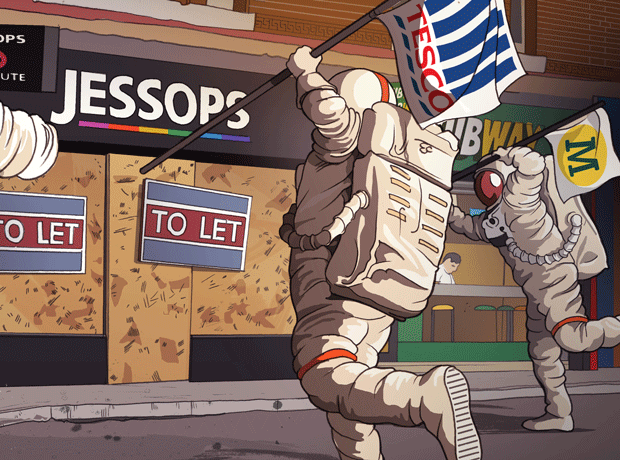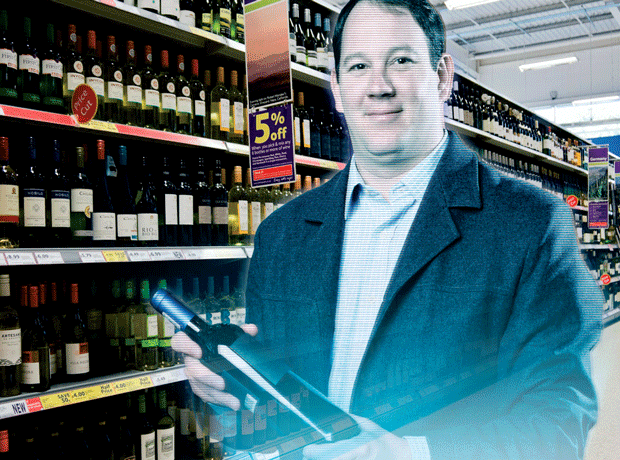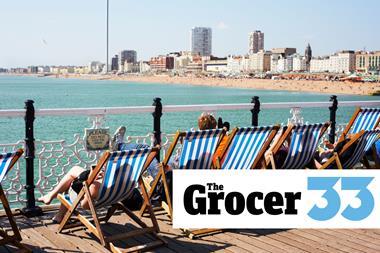The new space race is on. Even as the growth in superstores slows down, grocery chains are jostling for position in the rush to occupy the ‘new’ territory: high street-based convenience stores. One by one the supermarket chains have joined early leaders Tesco and Sainsbury’s in a battle to secure small stores in urban and suburban locations.
New figures underline the extent of this trend. According to UK construction data experts Glenigan, in 2011 there was a 140% increase in c-store planning applications made by the mults on the previous year. Although the number of c-store applications fell back last year, there were still almost twice as many plans tabled as in 2010. So what’s behind this new space race and does the push towards smaller stores spell the end for the hypermarket?
The attraction of c-stores is being fuelled by businesses that are “hooked on the drug of growth,” says Richard Hyman, president of retail consultants PatelMiller. “After 30 years of relentless development of hypermarkets, saturation has arrived. The last bastion of the grocery market that they had not yet penetrated was convenience.”
“Outside online sales, the convenience store is the only real growth area in grocery food”
David Roberts, The Co-operative Group
The timing of the new push couldn’t have been better. The collapse of high street chains Jessops, Blockbuster and HMV has provided a fresh crop of suitable convenience store locations, leaving grocery operators including Morrisons, Waitrose, Asda (as well as Tesco, Iceland, Budgens, Sainsbury’s and The Co-op Group), to fight over the choice morsels. In its quest to break into the convenience market Morrisons has been particularly acquisitive, snapping up seven Jessops, six HMVs and 49 Blockbuster stores in February alone.
“There is clearly an increase in the amount of top-up shopping going on, with households wanting to control their spending,” says independent retail analyst Nick Bubb. “That may be a temporary phenomenon, but austerity Britain will be with us for some time. Add to that the cost of the petrol for car-borne shoppers and the greater price transparency of convenience stores these days and you can see why the big chains are keen to increase their exposure to this market,” he says.
The rise of online shopping has also been a factor, argues David Roberts, director of property at The Co-operative Group. An increasing number of consumers are buying goods in bulk online every couple of weeks and supplementing that shop with fresh food from smaller outlets. “Outside online sales, the convenience store is the only real growth area in grocery food,” he adds.
Although the c-store format has its obvious attractions it’s not been easy for retailers to lay their hands on suitable sites to date. That’s because the mults are looking for very specific criteria, according to Steve Burnaby, head of retail agency at property consultants Colliers International, which acquires c-stores for Sainsbury’s in the South East. The ideal unit has a sales area of less than 3,000 sq ft, a further 1,500 sq ft of “back-of-house” space, is square, and has 10 to 15 parking spaces.
“Everybody wants the perfect unit, but more often than not it doesn’t really exist, so we will look at redeveloping parades of smaller high-street shops, converting filling stations, car showrooms, pubs and the ground floors of office buildings,” he says. “In some towns we need to work with developers to create space for us.”
Where planning permission is required, protest groups opposed to the homogenisation of high streets and the impact on local retailers can make life difficult for supermarket chains. James Owens, a director in the planning team at property consultancy Jones Lang LaSalle, says social media is empowering protesters. “It was previously expensive and hard to co-ordinate people, but now they can get hundreds of objections logged with councils at the touch of a button,” he warns.
Access for deliveries also limits the number of suitable locations. “We don’t want to upset the neighbours so we have to make sure lorries can get in and out without causing too much disruption,” says Roberts.
This is why units vacated by defunct high-street retailers are so attractive. They also have the added advantage of not requiring a change of use planning permission. They are not always ideally suited to food use, however. Some are located in pedestrian precincts, where passing trade dies away in the early evening. Others, like many of the HMV stores, lie within prime retailing areas where rents are high. Many units are also too small, says The Co-op’s Roberts.
“As ourselves, Tesco and Sainsbury’s have got into the c-store market, people’s expectations about being able to get fresh food have changed, so convenience stores are larger than they were. The starting size is now 2,000 sq ft.”
Of the recent receiverships, Blockbuster offers the best opportunities for conversion to food use, according to Tom Edston, head of food stores at Jones Lang LaSalle. “I expect all the operators will be looking at them. They are generally in convenience locations where people used to pick up their DVDs and they often have a couple of car parking spaces.”
That said, Sainsbury’s did not bid for any Blockbuster stores. “Blockbuster has been struggling for some time and we have already been through the units that were of any interest and picked them off,” says Burnaby.
Bubb also points out that the carnage on the high street offers opportunities for grocery chains’ rivals. “The demise of some high-street players is helping the supermarkets expand, although they have to be aware that it is also helping the discount, pound and bargain shops expand as well, which are an increasing thorn in their sides, given their expanded ranges, and push into branded groceries and toiletries,” says Bubb.
As a result, the multiples will also look to acquire businesses, says Chris Keen, a director at property consultancy CBRE. “Over 40% of c-stores are in the hands of independents and over 30% are with the symbols or franchises like Spar, Costcutter and Musgrave [which owns the Budgens brand],” says Keen. “The multiples are the fastest-growing but still represent a relatively small proportion of the market. It is no wonder they see such an opportunity for growth through convenience.”
The Co-op Group has employed this tactic, buying up 10 Costcutter shops and Scottish chain David Sands with its 28 convenience stores over the course of 2012. However, Roberts suggests such opportunities are becoming scarcer: “There are fewer chains out there now, so most expansion is likely to be through organic growth,” he says.
“The demise of the high-street players is also helping the discount, pound and bargain shops expand”
Nick Bubb, analyst
The end of the hypermarket?
The same consumer trends that have fuelled the growth of c-stores are also driving the emergence of a mid-sized format. In densely populated urban areas where the volume of trade is high enough, it’s worth sacrificing longer Sunday trading hours to entice customers with a wider range of fresh food. Keen expects this to prompt retailers to open more stores of 8,000 to 15,000 sq ft.
Whether these changes signal the end for the hypermarket remains to be seen. But the signs don’t look too good. Tesco announced in 2012 that it would not be building hypermarkets of more than 100,000 sq ft in size and Sainsbury’s also scaled back its expansion programme last year.
“There is a structural adjustment in consumers’ spending power,” says Clive Black, retail analyst at Shore Capital. “Living standards have contracted and that has put a brake on the appetite to develop superstores, not just in terms of numbers, but size of store. Tesco now talks about the ‘sweet spot’ being a store of 60,000 to 70,000 sq ft, not 120,000 sq ft. I would be amazed if someone in Britain opens a food-based hypermarket of more than 100,000 sq ft again.”
However, a large part of grocery chains’ business will continue to come from existing big stores and while the quantity of large food store space opened in the 2012/13 financial year is likely to fall to around three million sq ft, compared with 4.2 million sq ft the previous year, that is still substantial growth, according to Edston. He expects supermarkets will become fussier about where they build large stores rather than abandoning their expansion plans altogether: “Sites that are easy to deliver in the right locations will be delivered. Some of the more difficult locations will be questioned,” he predicts.
As to the question of whether or not the market can support the rapid projected growth of c-stores Burnaby says Sainsbury’s estimates a total of £35bn is spent in c-stores each year, of which the big chains account for only £2.5bn to £3bn, leaving a much bigger share of the market to be captured.
Roberts agrees: “There are many years of growth in the convenience sector,” he says. “When we put down new stores we are not necessarily stealing spending from other convenience retailers. That saturation point will come, but at the moment I only see the race for space in convenience speeding up, not slowing.”
At your convenience: the state of play
Tesco
Tesco opened its first standalone Tesco Express in 2002 and now trades from almost 1,500 as well as 621 smaller One Stops. It opened 60 Express stores in the first half of the 2012/13 financial year. In its interims it said it expected to open 1.5 million sq ft of new space over the year as a whole, of which nearly a quarter would be in Express format stores.
Sainsbury’s
Sainsbury’s announced the opening of its 500th c-store in November. It opened 49 Sainsbury’s Local stores in the first half of the 2012-13 financial year and plans to open a further one or two convenience shops each week. A spokesman says the company is experimenting with new formats including slightly bigger Superfresh stores.
Morrisons
A newcomer to the c-store market, Morrisons has established 13 Morrisons M local stores since July 2011. Gordon Mowat, MD of Morrisons Convenience, says the chain intends to open 50 more c-stores this year and plans a national network. A key point of difference with rivals, he claims, will be that half the space in M locals will be given over to fresh food.
Asda
Asda bought Netto’s 193 stores, averaging 8,000 sq ft, in May 2010, to create a new supermarkets division for stores of less than 25,000 sq ft. That was expected to herald a push into the c-store market but to date it has shown little sign of doing so and the supermarkets division numbers about 180 stores today. However, it is trialling two small forecourts.
The Co-operative Group
The Co-op Group operates 2,100 c-stores, of which 220 are located in petrol filling stations. Its expansion plans are focused on convenience. Of the 83 new stores opened in 2012, 75 were c-stores. Co-op Food director of property David Roberts says the business is seeking to open 100 new stores per year, around 90% of which will be c-stores.
Waitrose
Waitrose opened its first c-store in late 2008 and introduced its Little Waitrose format in January 2011. It has 36 c-stores in addition to 17 small stores in Welcome Break motorway service stations. It plans to open 10 further Little Waitroses in central London in 2013. A further modest expansion of about 10 stores within the M25 is slated for 2014.
The grocery store of the future

It may look distinctly low-tech through a modern lens, but the world’s first supermarket was revolutionary in its time…
- 1
- 2
 Currently
reading
Currently
reading
The new space race in grocery






















No comments yet